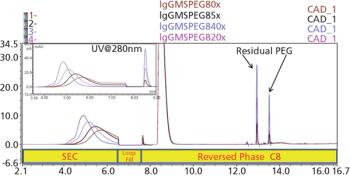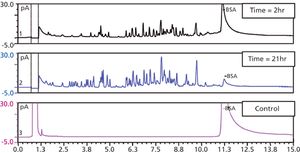Articles by Christopher Crafts

Biotherapeutic peptides and proteins are often PEGylated (covalently bonded to polyethylene glycol polymers) to improve bioavailability, reduce immunogenicity, and extend circulating half-life (1). Achieving the desired properties for each application depends on optimizing the number and site of polymers attached, chain length, and the degree of chain branching.

Selective cleavage of proteins by the enzyme trypsin helps characterize larger proteins. While MS provides structural information, quantitative analysis is often based on detection by UV at 214 nm.

High performance liquid chromatography (HPLC) with light absorbance detection (UV) is limited by the dependence of detector response on the structure of the analyte. Some detection techniques based on nebulization of the mobile phase and formation of Aerosol particles demonstrate an analyte independent response that approaches "universal."







